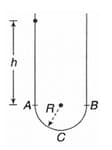Escape Velocity
Escape Velocity: Overview
This topic covers concepts such as conservation of mechanical energy, escape velocity, total energy of a body on surface of earth, and derivation of escape velocity based on conservation of energy.
Important Questions on Escape Velocity
The total energy of a body at an infinite distance from the earth's surface is equal to
What is the value of gravitational potential energy of an object at infinite distance from the earth surface.
Find the escape velocity of a body from the earth. [R (earth) = , (earth) = , G = ]
The escape velocity of an object from the earth depends upon the mass of earth (M), its mean density (), its radius (R), and gravitational constant (G), thus the formula for escape velocity is:
The escape velocity of a body from the earth’s surface, based on the principle of conservation of energy is = _____ .
Find the escape velocity of a body from the earth. [M(earth) = , R (earth) = , G ]
Using the law of conservation of energy, obtain the expression for the escape velocity.
The value of gravitational potential energy at an infinite distance from the earth is
What is the kinetic energy of an object when it is at infinite distance from the earth?
If a missile launched with a velocity less than escape velocity, the sum of its . and . is always
A shaped smooth wire has a semi-circular bend of radius between and . It is held fixed in a vertical plane. A bead of mass is released from height (above ) and slides smoothly along the wire to reach the same height on other side of the wire. It is given that .

Consider the motion of the bead between and the lowest point of the wire. The ratio of change in magnitude of velocity of the particle at to the magnitude of change in its velocity at is nearly equal to
